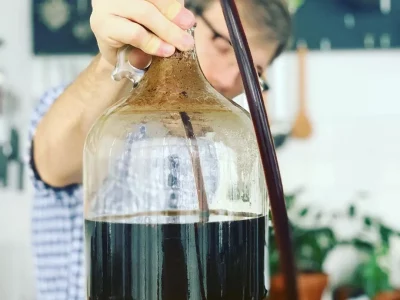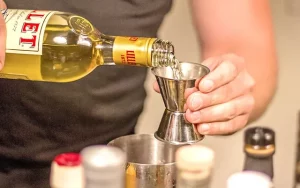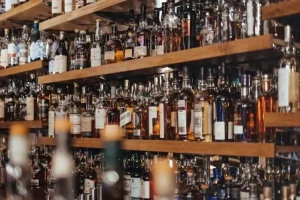If you’re interested in how to make liquor at home, then you are just in the right place It’s a fun and rewarding hobby that’s accessible to both experienced and novice distillers. All you need are a few basic ingredients and some basic equipment, and you can create your own unique and tasty spirits right in your own kitchen.
To make liquor at home, you will need to follow a recipe or instructional guide that outlines the specific ingredients, equipment, and steps involved in the process. It is important to note that some types of liquor require specialized equipment and techniques, and it may be illegal to produce liquor at home in some jurisdictions.
Additionally, it is important to exercise caution and follow safety guidelines when handling high-proof alcohol and working with heat sources.
How to make liquor at home
There are many different types of liquor that can be made at home, including vodka, gin, whiskey, rum, and more.
Here is a general overview of the process for making liquor at home:
- Gather your ingredients and equipment: Depending on the type of liquor you want to make, you will need a range of ingredients and equipment. For example, you may need grains, fruit, vegetables, spices, yeast, and water for the fermentation process. You will also need a large container for mixing and fermenting the ingredients, as well as a still or other equipment for distillation.
- Prepare your ingredients: Depending on the type of liquor you are making, you may need to grind, chop, or otherwise prepare your ingredients. For example, you may need to crush grains or chop fruit for fermentation.
- Mix and ferment the ingredients: Combine your prepared ingredients in a large container and add water, yeast, and any other necessary additives. Stir the mixture well and cover it with a lid or cloth. Allow the mixture to ferment for several days or weeks, depending on the recipe you are following.
- Distill the mixture: Once the fermentation process is complete, you will need to distill the mixture to increase the alcohol content and remove impurities. This can be done using a piece of still or other distillation equipment. The exact process will depend on the type of still you are using and the recipe you are following.
- Age the liquor: Some types of liquor, such as whiskey and rum, benefit from aging in barrels. If you want to age your liquor, transfer it to oak barrels or another suitable container and allow it to age for several months or years.
It is important to note that making liquor at home can be a complex and time-consuming process, and it requires a certain level of skill and knowledge. It is also important to follow safety guidelines when handling high-proof alcohol and working with heat sources. In some jurisdictions, it may be illegal to produce liquor at home.
Easy recipes for homemade liquor
Here are a few easy recipes for homemade liquor that you can try:
Vodka:
- Combine 8 pounds of white granulated sugar, 1 packet of champagne yeast, and 5 gallons of water in a large fermenting container.
- Stir the mixture well to dissolve the sugar, then cover the container with a cloth and set it aside in a warm place for 5-7 days or until fermentation is complete.
- Transfer the fermented mixture to a still and follow the instructions for your particular still to distill the vodka.
Gin:
- Combine 1 liter of vodka, 2 tablespoons of juniper berries, 1 tablespoon of coriander seeds, 1 tablespoon of angelica root, and a few strips of citrus peel in a jar.
- Seal the jar and let it sit for 1-2 weeks, shaking it occasionally.
- Strain the mixture through a cheesecloth and discard the solids.
- Transfer the infused vodka to a still and follow the instructions for your particular still to distill the gin.
Limoncello:
- Peel the zest from 6 lemons using a vegetable peeler, taking care to avoid the white pith.
- Combine the lemon zest, 1 liter of vodka, and 1 cup of white granulated sugar in a jar.
- Seal the jar and let it sit for 1-2 weeks, shaking it occasionally.
- Strain the mixture through a cheesecloth and discard the solids.
- Dilute the infused vodka with an equal amount of water and sweeten it to taste with additional sugar if desired.
Note: These are just a few simple examples, and there are many other types of homemade liquor that you can make using different ingredients and techniques.
It is important to follow a reliable recipe or instructional guide and to exercise caution when handling high-proof alcohol. In some jurisdictions, it may be illegal to produce liquor at home.
What ingredients are needed to make liquor at home?
The specific ingredients needed to make liquor at home will depend on the type of liquor you want to make.
Here are some common ingredients used in the production of different types of liquor:
- Grains: Grains such as corn, wheat, barley, and rye are often used as the base for many types of liquor, including whiskey, vodka, and gin.
- Fruit: Fruit, such as grapes, apples, berries, and citrus, can be used to make brandy, wine, and liqueurs.
- Vegetables: Vegetables, such as potatoes and beets, can be used to make vodka.
- Spices: Spices, such as coriander, angelica root, and juniper berries, can be used to add flavor to gin and other types of liquor.
- Water: Water is a crucial ingredient in the production of all types of liquor, as it is used to dissolve sugars and other solids and to regulate the fermentation process.
- Yeast: Yeast is used to converting sugars into alcohol during the fermentation process. Different types of yeast are used to make different types of liquor.
In addition to these ingredients, you may need other additives, such as enzymes or nutrients, to aid in the fermentation process. You will also need a range of equipment, including a large container for mixing and fermenting the ingredients and still or other equipment for distillation.
What equipment is necessary to make liquor at home?
The specific equipment needed to make liquor at home will depend on the type of liquor you want to make and the process you are using.
Here is a list of some common equipment used in the production of homemade liquor:
- Fermenting container: A large container, such as a food-grade plastic bucket or a glass carboy, is used to mix and ferment the ingredients.
- Airlock: An airlock is a device that allows gases to escape from the fermenting container while preventing air from entering. This helps to prevent contamination and regulate the fermentation process.
- Hydrometer: A hydrometer is a device that measures the specific gravity of a liquid. It is used to determine the alcohol content of the fermented mixture and to monitor the progress of the fermentation process.
- Still: A still is a piece of equipment used to distill the fermented mixture and increase the alcohol content. There are many different types of stills available, including pot stills, column stills, and reflux stills.
- Thermometer: A thermometer is used to measure the temperature of the fermented mixture during the distillation process.
- Barrels: Some types of liquor, such as whiskey and rum, benefit from aging in barrels. If you want to age your liquor, you will need oak barrels or another suitable container.
In addition to these pieces of equipment, you may need other items, such as a funnel, a strainer, and a bottle filler, to transfer the finished product into bottles or other containers.
It is important to use high-quality, food-grade equipment when making liquor at home to ensure the safety and quality of the final product.
Is it legal to make liquor at home?
The legality of making liquor at home varies by jurisdiction. In some places, it is legal to produce small amounts of liquor for personal consumption, while in other places, it is strictly prohibited. It is important to check the laws in your area before attempting to make liquor at home.
In the United States, federal law allows individuals to produce up to 200 proof gallons of liquor per year for personal consumption, but not for sale. However, state laws may be more restrictive. Some states allow home distillation, while others do not. It is important to check the laws in your state before attempting to make liquor at home.
In Canada, it is illegal to produce any amount of liquor at home, even for personal consumption.
In the United Kingdom, it is illegal to produce any amount of liquor at home, even for personal consumption.
In Australia, it is illegal to produce any amount of liquor at home, even for personal consumption.
It is important to note that even if it is legal to produce liquor at home in your jurisdiction, it is still a complex and potentially hazardous process that requires a certain level of skill and knowledge. It is important to exercise caution and follow safety guidelines when handling high-proof alcohol and working with heat sources.
How to make vodka at home
Here is a simple recipe for making vodka at home:
Ingredients:
- 8 pounds of white granulated sugar
- 1 packet of champagne yeast
- 5 gallons of water
Equipment:
- Large fermenting container
- Airlock
- Hydrometer
- Still
- Thermometer
Instructions:
- Combine the sugar, yeast, and water in the fermenting container. Stir the mixture well to dissolve the sugar, then cover the container with a cloth.
- Set the container aside in a warm place (around 70-75 degrees Fahrenheit) and allow the mixture to ferment for 5-7 days or until fermentation is complete. You can monitor the progress of the fermentation process using a hydrometer.
- Once the fermentation process is complete, transfer the fermented mixture to the still.
- Follow the instructions for your particular still to distill the vodka. The exact process will depend on the type of still you are using.
- As the vodka distills, monitor the temperature and alcohol content using a thermometer and a hydrometer.
- When the distillation process is complete, transfer the finished vodka to a clean container for storage.
How to make gin at home
Here is a simple recipe for making gin at home:
Ingredients:
- 1 liter of vodka
- 2 tablespoons of juniper berries
- 1 tablespoon of coriander seeds
- 1 tablespoon of angelica root
- A few strips of citrus peel
Equipment:
- Jar
- Cheesecloth
- Still
Instructions:
- Combine the vodka, juniper berries, coriander seeds, angelica root, and citrus peel in the jar.
- Seal the jar and let it sit for 1-2 weeks, shaking it occasionally.
- Strain the mixture through a cheesecloth and discard the solids.
- Transfer the infused vodka to the still.
- Follow the instructions for your particular still to distill the gin. The exact process will depend on the type of still you are using.
- When the distillation process is complete, transfer the finished gin to a clean container for storage.
How to make whiskey at home
Making whiskey at home can be a fun and rewarding hobby, but it does require some specialized equipment and ingredients, as well as a good understanding of the distillation process.
Here are the basic steps for making whiskey at home:
1. Gather your equipment:
You will need a fermenting vessel, such as a large food-grade plastic bucket or a glass carboy, a still, and some clean bottles for storage. You will also need a hydrometer to measure the alcohol content of your whiskey, as well as a thermometer and a pH meter.
2. Make your mash:
The first step in making whiskey is to create a mash, which is a mixture of grain, water, and yeast. The grain is typically a combination of malted barley, corn, and rye, although you can use other grains such as wheat or oats. You will need to soak the grains in hot water to extract the sugars, then add yeast to begin the fermentation process.
3. Ferment the mash:
Once you have made your mash, you will need to let it ferment for several days to a week. During this time, the yeast will consume the sugars and produce alcohol. You will need to keep the temperature of the mash between 65-80°F and monitor the pH and specific gravity with a hydrometer.
4. Distill the whiskey:
Once the fermentation is complete, you will need to distill the whiskey to increase the alcohol content. This is done using a still, which will vaporize the alcohol and condense it back into a liquid. The distillation process can take several hours, and you will need to pay careful attention to the temperature and alcohol content of the distillate.
5. Age the whiskey:
Once the distillation is complete, you will need to age your whiskey in oak barrels for at least a few months to a few years. This will give the whiskey its characteristic flavor and color. You will need to choose the right type of barrels and monitor the temperature and humidity of your aging room to ensure the best possible results.
Recommended:
- Best drinks to order at a bar for a man
- How long is red wine good for after opening?
- Does rum go bad?
Conclusion
Here you get to learn how to make liquor at home. To make liquor at home, follow a recipe or guide that includes the proper ingredients and equipment, follow proper distillation techniques, and properly age and store the finished product for the best results.




